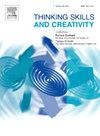Exploring the developmental trajectory of students' creative thinking and intellectual interaction in a computer-supported collaborative learning environment
IF 4.5
2区 教育学
Q1 Social Sciences
引用次数: 0
Abstract
Creative thinking is increasingly regarded as a core competency essential for addressing complex challenges in the 21st century. Although previous studies have explored strategies for fostering creativity in educational settings, limited attention has been given to how creative thinking develops within computer-supported collaborative learning (CSCL) environments guided by the design thinking (DT) framework. This study aims to bridge this research gap by examining the effects of a DT-CSCL intervention on students’ creative thinking development and by mapping the progression of creative thinking across the different stages of the design thinking process. A mixed-methods research design was employed with 40 vocational college students participating in the study. Data sources included students’ creative design task outputs and collaborative discourse collected from WeChat-based learning groups. Creative thinking was assessed using a revised coding scheme that captured both divergent and convergent thinking dimensions. Epistemic Network Analysis (ENA) was used to analyze discourse data, enabling a comparative analysis of creative thinking patterns among students with high and low design performance, as well as tracing its evolution across DT stages. The results revealed notable differences between high- and low-performing students: high-performing students demonstrated stronger integration between divergent and convergent thinking, particularly in the areas of elaboration, synthesis, and decision-making. Conversely, low-performing students showed initial potential in idea generation but struggled with elaboration and refinement. Moreover, creative thinking followed a dynamic trajectory across the DT-CSCL stages, shifting from predominantly divergent to more convergent forms as students progressed through the design cycle. These findings highlight the importance of stage-specific instructional scaffolds in DT-CSCL settings and suggest that tailoring pedagogical strategies to the cognitive demands of each design phase can more effectively support students’ creative thinking development.
探讨在电脑支援的协作学习环境下,学生的创造性思维及智力互动的发展轨迹
创造性思维越来越被视为应对21世纪复杂挑战的核心能力。虽然以前的研究已经探索了在教育环境中培养创造力的策略,但在设计思维(DT)框架的指导下,创造性思维如何在计算机支持的协作学习(CSCL)环境中发展的关注有限。本研究旨在通过考察DT-CSCL干预对学生创造性思维发展的影响,并通过绘制创造性思维在设计思维过程不同阶段的进展图,来弥补这一研究空白。采用混合方法研究设计,40名高职学生参与研究。数据来源包括学生的创意设计任务输出和从基于微信的学习小组收集的协作话语。创造性思维的评估使用了一种修订后的编码方案,该方案捕捉了发散性思维和收敛性思维的维度。运用认知网络分析(ENA)对话语数据进行分析,对比分析高、低设计水平学生的创造性思维模式,并追踪其在不同设计阶段的演变。结果显示,表现优异的学生和表现不佳的学生之间存在显著差异:表现优异的学生在发散思维和收敛思维之间表现出更强的融合,尤其是在阐述、综合和决策方面。相反,表现不佳的学生在想法产生方面表现出最初的潜力,但在阐述和提炼方面却存在困难。此外,创造性思维遵循着DT-CSCL各个阶段的动态轨迹,随着学生在设计周期中的进展,从主要的发散形式转向更趋同的形式。这些发现强调了在DT-CSCL环境下,阶段化教学框架的重要性,并表明根据每个设计阶段的认知需求定制教学策略可以更有效地支持学生的创造性思维发展。
本文章由计算机程序翻译,如有差异,请以英文原文为准。
求助全文
约1分钟内获得全文
求助全文
来源期刊

Thinking Skills and Creativity
EDUCATION & EDUCATIONAL RESEARCH-
CiteScore
6.40
自引率
16.20%
发文量
172
审稿时长
76 days
期刊介绍:
Thinking Skills and Creativity is a new journal providing a peer-reviewed forum for communication and debate for the community of researchers interested in teaching for thinking and creativity. Papers may represent a variety of theoretical perspectives and methodological approaches and may relate to any age level in a diversity of settings: formal and informal, education and work-based.
 求助内容:
求助内容: 应助结果提醒方式:
应助结果提醒方式:


